“Romanticism in Corfu” curated by Dr Megakles Rogakos at the Ionian University, Corfu, 2 – 26 August 2018. Eventbrite
CORFU.- As it is well known, George IV, when he was Prince Regent of the United Kingdom, founded the Order of St Michael and St George in Corfu and in Malta on 28 April 1818, two hundred years ago. This forms part of Corfu’s history and belongs to its heritage. To celebrate the Order’s bicentenary, the Corfu Heritage Foundation is organising the Corfu Festival 2018, which is to include a series of cultural events encompassing literature, music, visual arts and sports.
This Festival is taking place under the auspices of the British Embassy, Athens, the Hellenic Republic’s Ministries of Culture and Tourism, and the Municipality of Corfu, between 7 July and 30 September 2018.
The painting exhibition “Romanticism in Corfu”, curated by Megakles Rogakos, includes 28 works, covering the period 1820-1920, never before shown together on Corfu. The earliest works are eight by Joseph Cartwright (England, 1789-1829), who served in the British Navy as a civilian artist, from his “Views in the Ionian Islands” album, published in 1821. Other works are by John Skene (England, 1780-1855), William Page (England, 1794-1872), John-Connell Ogle (Scotland, 1801-1870), George Pechell-Sands (England, 1810-1895), Thomas-Miles Richardson (England, 1813-1890), John Fulleylove (England, 1847-1908) and Sir William Herries (England, 1859-1923). The Schranz father and son – Anton (Germany, 1769-1839) and Joseph (Germany, 1803-1853) – are represented by two works each from the two periods of their visit to Corfu, 1826 and 1840. Included are three works by Edward Lear (England, 1812-1888), a famous writer and painter, who taught painting to Queen Victoria. Female painters are represented by Mrs. D. Payne Galliwell (England, 1860-1910) and Sarah Markham (England, 1865-1915). Herman Melville (USA, 1819-1891), author of Moby Dick(1851), is represented by one work. Tristram Ellis (England, 1844-1922), known for depicting the Eastern Mediterranean, is represented by two works. Two Corfiot prominent water-colourists – Angelos Giallina (Greece, 1857-1939) and Spyridon Scarvelli (Greece, 1868-1942) are also represented in the exhibition. All of these works offer a representative romantic picture of the then urban life and landscape scenery in Corfu.
Mr Derek Johns writes in his introduction: “Romanticism was characterised by its emphasis on emotion and individualism as well as glorification of all the past and nature, preferring the medieval and the exotic rather than the classical.”
Dr Rogakos writes in his essay: “Romanticism seems endemic on Corfu, an island enshrouded in a veil of legend and mystery. Its unique ancient history is transformed in post-mythological times with the island’s natural attributes and built monuments with which it is blessed – Archaic temples, Byzantine churches, medieval castles, Venetian mansions, and neoclassical palaces.”
The romantic quality is evoked in the paintings focusing primarily on two collections from London. One collection is formed by the Corfu-born Count Spiro Flamburiari, who exemplarily cares for the history and heritage of the island. The other originates with the English born Derek Johns, former partner in Sotheby’s London, who adores the island and made it his home. So, by their mutual love for Corfu, this exhibition celebrates British-Hellenic relations at their best.
The “Romanticism in Corfu” exhibition will be presented at the Ionian University, Corfu, in 2 – 26 August 2018. Mr Johns will present his related lecture at the Corfu Reading Society at 7.30pm on Friday, 3 August 2018.
Accompanying Catalogue: A fully-illustrated 130-page catalogue, including the “Introduction to Romanticism” by Mr Johns and Dr Rogakos’ essay for the “Romanticism in Corfu” exhibition, is published by the Corfu Heritage Foundation (ISBN: 978-618-83770-0-4).
Public Information
Exhibition:“Romanticism in Corfu” curated by Dr Megakles Rogakos
Opening: 8pm, Thursday, 2 August 2018
Duration: 2 – 26 August 2018
Venue: Ionian University, 1 Kapodistriou & Akadimias Street, 49100 Corfu, Greece
www.ionio.gr/en/prospective/university-history
Opening Hours: 8.30am – 9pm daily, except Sunday
Communication: Mrs Ioanna Anemogianni, +30 26610 87202, secretariat@ionio.gr
Visuals: https://www.corfuheritagefoundation.org/romanticism-in-corfu/
Free Tickets: Eventbrite
Lecture: “Introduction to Romanticism” by Mr Derek Johns
Day and Time: 7.30pm, Friday, 3 August 2018
Corfu Reading Society: Mrs Xenia Balbi, 120 Kapodistriou Street, 49100 Corfu, Greece, +30 26610 39528, anagnostikicorfu@gmail.com, www.anagnostiki-etairia-kerkyras.eu
“Romanticism in Corfu”
By Megakles Rogakos, MA MA PhD
Romanticism is the label given to the movement in the arts and literature that originated in the late 18th century, emphasising inspiration, subjectivity, and the primacy of the individual. It was a reaction against the order and restraint of classicism and neoclassicism, and a rejection of the rationalism that characterised the Enlightenment. It can further be taken as a haven for the appearing fault-lines in art from modernism onwards. The romantic envisages the unattainable, beyond the limits of rationality. The romantic view becomes poetry. It enhances the meaning of spiritual and emotional qualities. It expands poetic awareness beyond the pictorial framework. It concerns the sentimental sphere, the dream world, the fantasy of inspiration.
Romanticism may well apply on Corfu, an island enshrouded in a veil of legend and mystery. Thucydides, father of scientific history, identifies the Homeric Phaeacia as Corfu. Homer speaks of the Phaeacians as an extraordinary people, possessing ships steered by thought and swifter than falcons, having robotic dogs constructed by Hephaestus guard their palace, and as tending fruit-bearing trees that grow year-round. So, in mythology, Corfu is an island like no other. Corfu is likely to be the island of salvation where Prospero and Miranda escape in William Shakespeare’s The Tempest (1611). Such uniqueness is transformed in post-mythological times. There are its natural attributes – immense groves of olive trees with the cypresses, hills thickly covered with pine trees, the calm environment of lake and lagoon, rocky coastal areas, as well as silver sand beaches with crystal clear turquoise waters; and the views of the Straits, breath-taking with the mainland mountains in the distance across the narrow waters. Then again, there are amazing built monuments with which the Island is blessed – Archaic temples, Byzantine churches, medieval castles, Venetian mansions, and neoclassical palaces.
Visiting Corfu first in 1848, Edward Lear was immediately entranced by it, acknowledging in a letter to his sister, “it really is a Paradise”. Such characterisation of Corfu laconically sums up the romantic scope in that region of the world – the paradisiacal with overpowering phenomena, sublime beauty and numinous power. The romantic quality of Corfu is evoked in the paintings, from two London collections. One collection was formed by the Corfu-born Count Spiro Flamburiari, who for years has been involved in caring for the history and heritage of the island. The other originates with the English-born Derek Johns, former partner in Sotheby’s London, who adores the island and made it his home. So, by their mutual love for Corfu, like Lear’s, this exhibition celebrates Anglo-Corfiot relations at their best.
Works in the “Romanticism in Corfu” Exhibition
[The dimensions are given in centimetres – height before width]

Joseph Cartwright (England, 1785-1829). View of Kanoni from Lake Chalikiopoulou, c. 1820. Watercolour on paper, 28 x 49. Courtesy of Derek Johns Family Trust, London.

Joseph Cartwright (England, 1785-1829). View of the Esplanade with the Maitland Memorial, c. 1820. Watercolour on paper, 19 x 28. Courtesy of Derek Johns Family Trust, London.
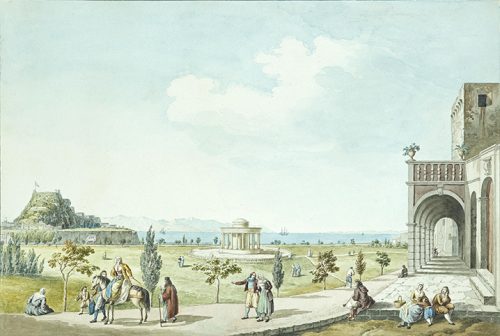
Joseph Cartwright (England, 1785-1829). View of the Esplanade from the Giallina House, c. 1820. Watercolour on paper, 19 x 28. Courtesy of Derek Johns Family Trust, London.
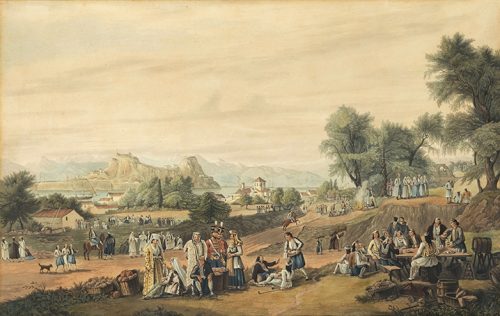
Joseph Cartwright (England, 1789-1829). View of the Old Fortress from the Hill of the Analipsis, 1821. Ink and aquatint on paper, 38 x 60. Courtesy of Spiro Flamburiari, London.

Joseph Cartwright (England, 1789-1829). View of Pontikonisi, Corfu, 1821. Ink and aquatint on paper, 38 x 60. Courtesy of Spiro Flamburiari, London.

Joseph Cartwright (England, 1789-1829). Procession of Saint Spyridon, Corfu, 1821. Ink and aquatint on paper, 38 x 60. Courtesy of Spiro Flamburiari, London.

Joseph Cartwright (England, 1789-1829). View of the Corfu Town from Vido, 1821. Ink and aquatint on paper, 38 x 60. Courtesy of Spiro Flamburiari, London.
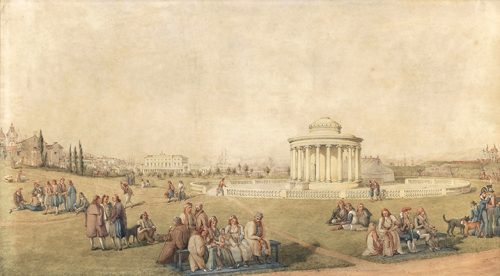
Joseph Cartwright (England, 1789-1829). The Rotunda at the Upper Esplanade, Corfu, c. 1825. Watercolour on paper, 30 x 55. Courtesy of Spiro Flamburiari, London.
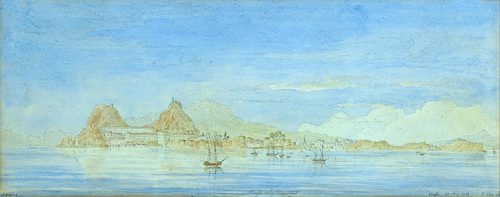
John Skene (England, 1780-1855). View of the Old Fortress from Vido, 1838. Watercolour on paper, 16 x 42. Courtesy of Derek Johns Family Trust, London.
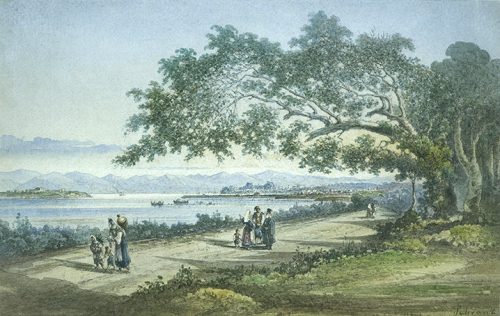
Anton Schranz (Germany, 1769-1839). View of the Old Fortress and Vido from Kontokali, 1826. Gouache on paper, 28 x 42. Courtesy of Derek Johns Family Trust, London.
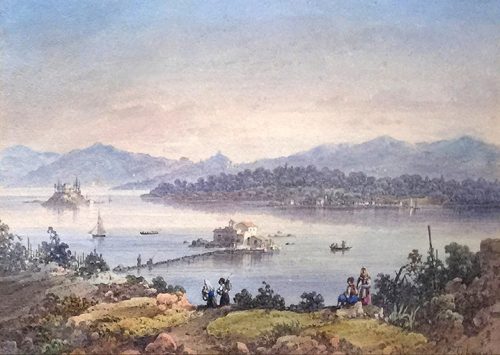
Joseph Schranz (Germany, 1803-1853). Vlacherna and Pontikonisi, Corfu, 1840. Watercolour on paper, 21 x 29. Courtesy of Spiro Flamburiari, London.
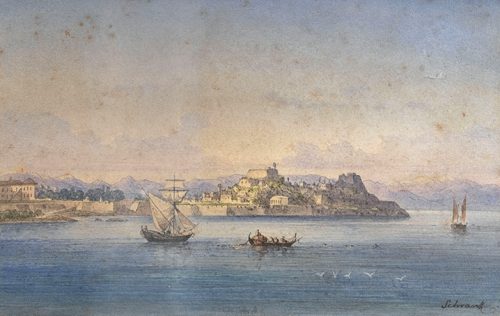
Joseph Schranz (Germany, 1803-1853). View of the Old Fortress, Corfu, 1840. Watercolour on paper, 16 x 27. Courtesy of Spiro Flamburiari, London.

William Page (England, 1794-1872). View of Albanian Mountains from Kassiopi, c. 1821. Watercolour paper, 34 x 44. Courtesy of Spiro Flamburiari, London.

Edward Lear (England, 1812-1888). View of the Albanian Mountains from Sfakera, 23 June 1857. Ink and watercolour on paper, 20 x 31. Courtesy of Derek Johns Family Trust, London.
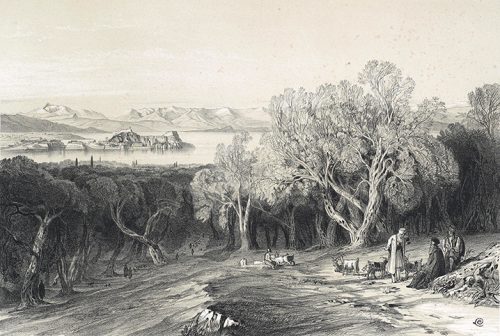
Edward Lear (England, 1812-1888). View to the North from the Ascension Village, 1863. Black and white lithograph on paper, 30 x 42. Courtesy of Derek Johns Family Trust, London.
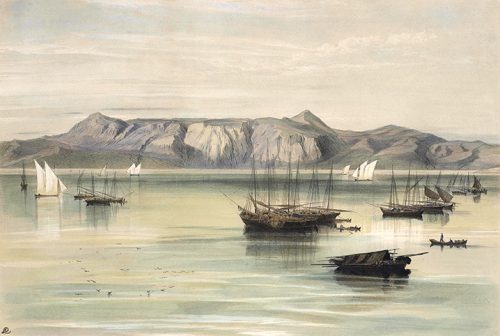
Edward Lear (England, 1812-1888). Mount San Salvador (Pantokrator) from the South, 1863. Coloured lithograph on paper, 28 x 38. Courtesy of Derek Johns, London.
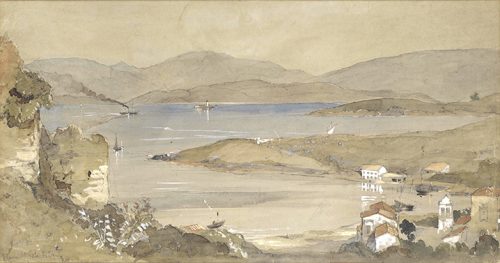
John Connell Ogle (Scotland, 1801-1870). View of Avlaki from Kassiopi Castle, 1849. Watercolour on paper, 25 x 47. Courtesy of Derek Johns Family Trust, London.
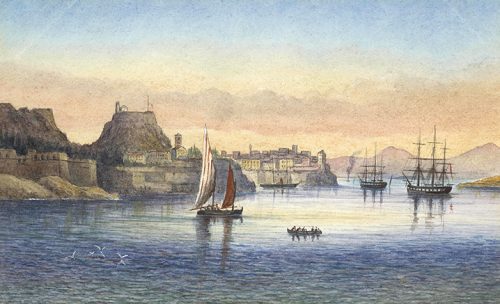
George Pechell-Sands (England, 1810-1895). Fanciful view οf the Old Fortress from the Sea, c. 1860. Watercolour on paper, 14 x 23. Courtesy of Derek Johns Family Trust, London.

John Fulleylove (England, 1847-1908). View of the Old Fortress from the New Fortress Bell Tower, c. 1865. Watercolour on paper, 17 x 24. Courtesy of Derek Johns Family Trust, London.

Thomas-Miles Richardson (England, 1813-1890). View of the Old Fortress from Garitsa Bay, 1872. Watercolour, 22 x 28. Courtesy of Derek Johns Family Trust, London.
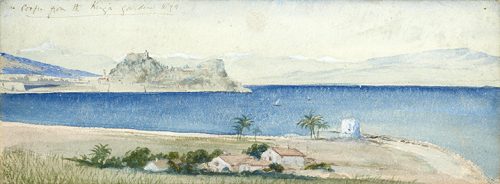
Herman Melville (USA, 1819-1891). View of the Old Fortress from the Palace of Mon Repos, 1879. Watercolour on paper, 11 x 30. Courtesy of Derek Johns Family Trust, London.
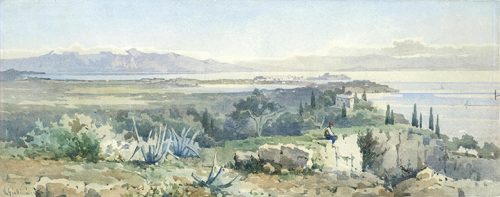
Angelos Giallina (Greece, 1857-1939). View of the Achilleon from Agioi Deka, 1885. Watercolour on paper, 21 x 51. Courtesy of Derek Johns Family Trust, London.

Mrs D. Payne Galliwell (England, c. 1860-1910). View of Old Fortress from the Palace of Mon Repos, c. 1890. Watercolour on paper, 28 x 37. Courtesy of Derek Johns Family Trust, London.
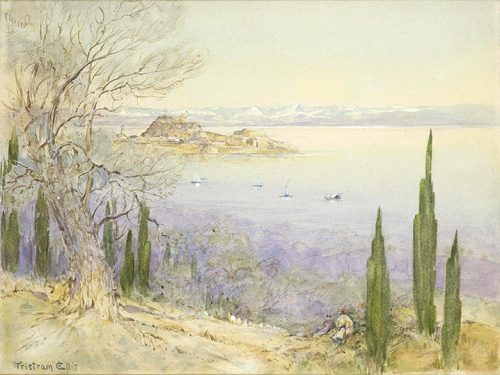
Tristram Ellis (England, 1844-1922). View of the Old Fortress from the Ascension Village, 1905. Watercolour on paper, 23 x 33. Courtesy of Derek Johns Family Trust, London.
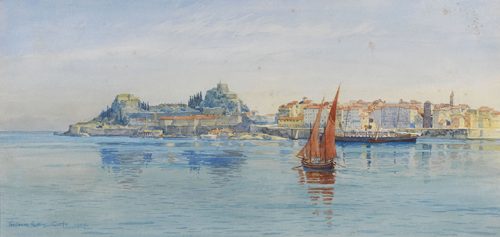
Tristram Ellis (England, 1844-1922). View of the Old Fortress and Mouragia from the Sea, 1909. Watercolour on paper, 23 x 33. Courtesy of Spiro Flamburiari, London.
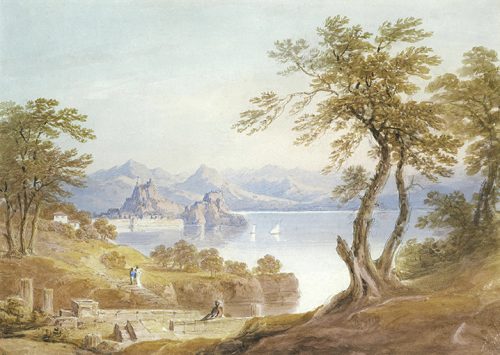
Sarah Markham (England, 1865-1915). View of the Old Fortress from Paleopolis, c. 1900. Watercolour on paper, 23 x 33). Courtesy of Derek Johns Family Trust, London.

Spyridon Scarvelli (Greece, 1868-1942). Vlacherna and Pontikonisi, Corfu, c. 1900. Watercolour on paper, 29 x 47. Courtesy of Spiro Flamburiari, London.

Spyridon Scarvelli (Greece, 1868-1942). Kontokali Bay, Corfu, c. 1920. Watercolour on paper, 26 x 47. Courtesy of Spiro Flamburiari, London.
Public Information
“Romanticism in Corfu”
Curated by Megakles Rogakos
Opening: 8pm, Thursday, 2 August 2018
Duration: 2 – 26 August 2018
Venue: Ionian Academy, 1 Kapodistriou & Akadimias Street, 49100 Corfu, Greece
www.ionio.gr/en/prospective/university-history
Opening Hours: 8.30am – 9pm daily, except Sunday
Communication: Mrs Dionysia Karvouni, +30 26610 87129, int_rel@ionio.gr
Visuals: www.corfuheritagefoundation.org/prossalendis-britannia-contemporary/
Reservation: Eventbrite

Re- the excellent exhibition on Romanticism in Corfu, I noted that you included one painting by William Page dated c.1850. In your research in compiling the exhibition and the associated catalogue, did you come across other paintings of Corfu by Page dated c. 1820. I am trying to find a link between Page’s visit to lake Ioanninia in c.1820 with a visit by him to Corfu at about the same time. Page represents my current research project. Thank you.